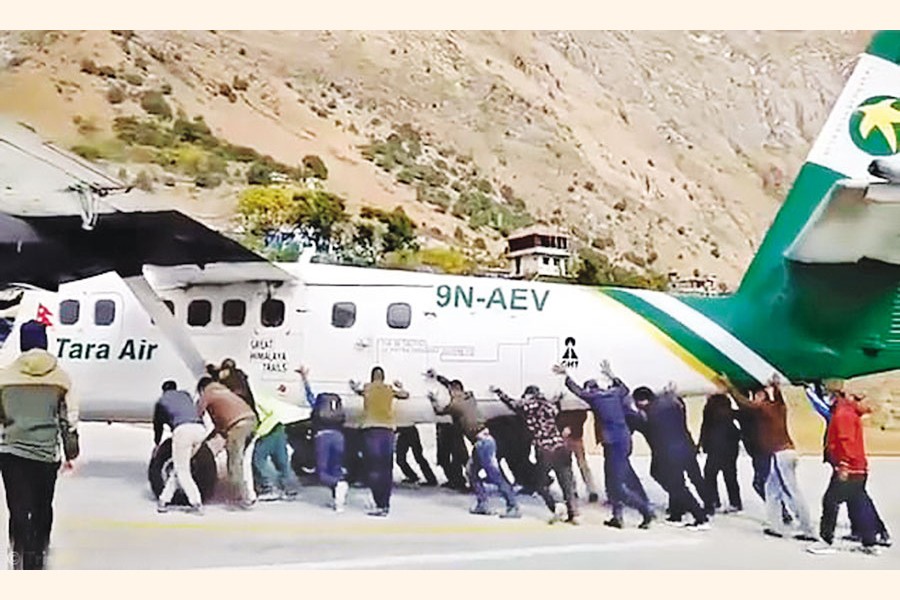
Published :
Updated :

For auto-rickshaws, cars, buses and trucks, it is not quite unusual to suddenly stop moving right on the middle of the road. Much as the driver may try to reignite the engine, it refuses to take command. At times it is an awfully embarrassing situation when the traffic following behind are forced to a standstill and the drivers of other vehicles hurl abuses at the culprit for whom they too are stuck.
In a rare incident, though, passengers had to push a plane off the runway. Of course, they volunteered to do so, for it is none of their business to move the plane they flew minutes ago to land at that runway. The passengers had to pay for their flight and are in no way compelled to lend a hand to such an odd task.
It happened in Nepal's Kolti Airport immediately after the landing of the plane. At the time of its landing, its rear tyre burst, mercifully causing no accident. The passengers could disembark safely. But the airport, like others in the lap of mountains but neither highly frequented nor well-equipped to respond to emergencies, was ready for receiving yet another aircraft then. As there was no pushback tractor to tow the plane off the track, the passengers were requested to give a hand each to the task. They complied. One of the reasons for them to readily agree to the instant laborious service may be they felt grateful for not suffering the worst fate due to the bursting of the tyre at the time of landing. The other reason might be their luggage which could not be taken out before the plane was moved to the safe zone.
Now the troubling question is, why an airport in a country known for mountain ranges and often carved out of hills or mountains is not adequately equipped to meet an emergency like this. The passengers could refuse to comply with the request. In a similar incident at Siberia's Igarka Airport in November 2014, passengers due to take a flight had to get down and push the aircraft when its brake pads froze solid due to -53 degree Centigrade. The plane tried its best to take off but was unable to move because of the unusual drop in temperature froze the brake pads. Igarka lies 100 miles north of the Arctic Circle, so cold weather is not uncommon but on that day the temperature was lower than normal. There was the pushback tractor but it could not move the aircraft an inch.
It is exactly at this point the passengers, many of them shift workers, decided to lend a hand to move the plane on to the taxiway. They did so because they feared, their journey would be delayed. Their effort was successful and the plane took off successfully to reach them to their destination.
So far so good! But concerned here is the legal issue of pushing an aircraft by hand. Such an act is not permissible even in Russia where plane travel is treated almost like any other land travel. A push or shove by hand can damage the skin of an aircraft, so it is legally punishable under the aviation law even in Russia. So prosecutors took up the issue to probe into the incident if the airport, the airline, the crew or the passengers broke any air safety laws.
In case of the Nepalese plane, no such question has been raised. In fact, in poorer parts of the world, the benchmark of sophistication and safety rules are set much lower. It is because of this, the ramshackle buses can run on the roads of Bangladesh's capital Dhaka. Those should have long been dumped at the junk yards but no one cares. The ugly, scratched, disfigured and partly broken and damaged with interior arrangement so dirty and threatening injuries, the buses certainly do not make a country poised to fully attain the status of a middle-income one proud at all.
These are symptoms of underdevelopment. That is why an aircraft is pushed like a pushcart on the muddy road in a village. The journeys from a pushcart to an aircraft somehow find a meeting point. People are not even aware that the sophisticated machines and equipment require a high degree of maintenance and care. The backup systems also should be always ready to meet an emergency.


 For all latest news, follow The Financial Express Google News channel.
For all latest news, follow The Financial Express Google News channel.